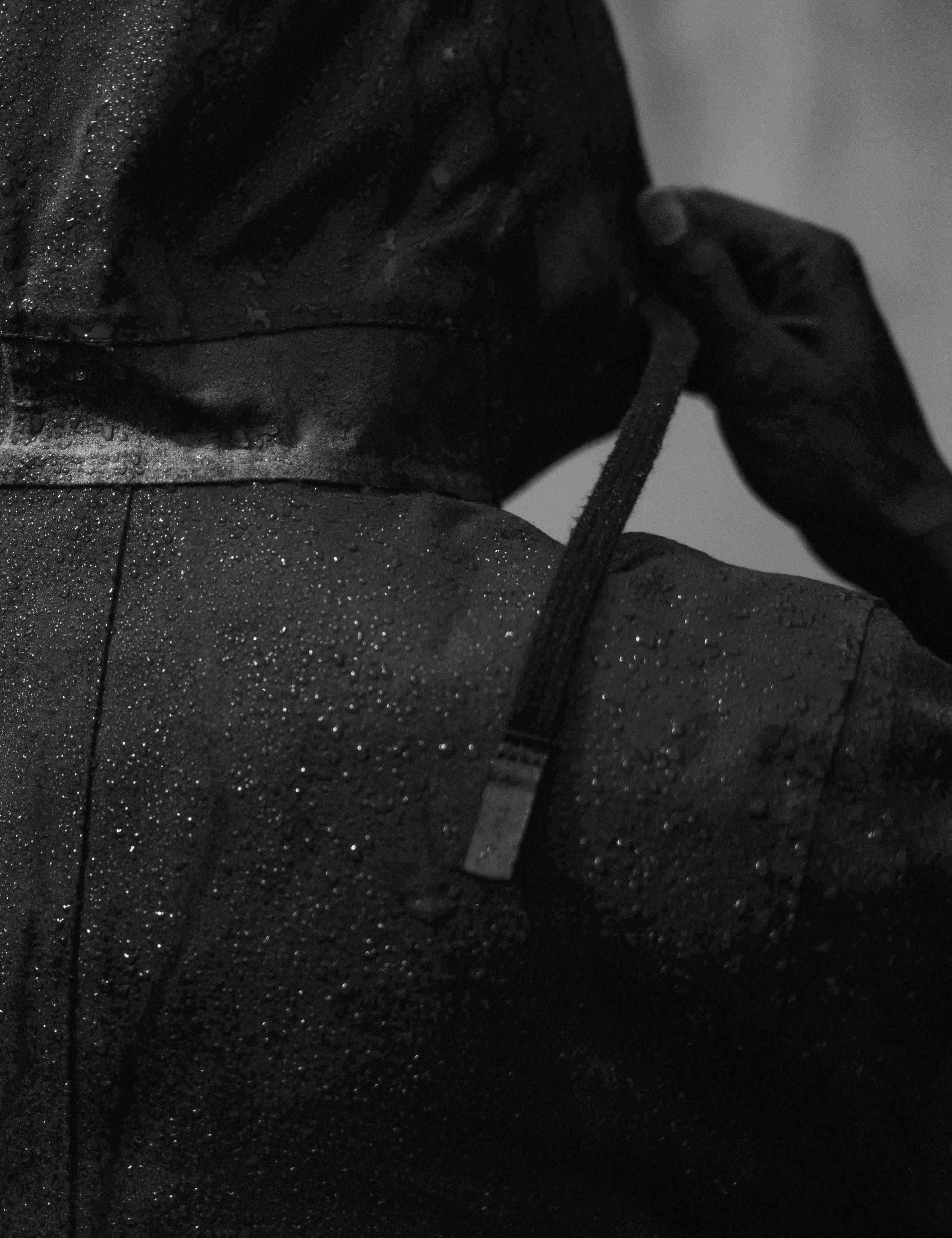Product Care


A guide to taking care of your AETHER gear.
At AETHER, we take pride in crafting gear that not only looks great but also performs when you need it most. However, the longevity and performance of your gear also depends on how well it’s cared for. Proper maintenance extends the life of your favorite pieces and ensures they continue to protect you through all your adventures.
These guidelines provide general tips for taking care of your AETHER gear, but always refer to the garment's care label for specific instructions.
For any additional clarification, feel free to reach out to us at hello@aetherapparel.com—we're here to help!
Care Instructions
Washing Instructions
- Use a mild detergent or a detergent specifically designed for technical fabrics. Don’t use fabric softeners, bleach, or harsh chemicals that could compromise the garment's performance. Some options for technical detergents include Nikwax Tech Wash, Gear Aid, and Granger’s Performance Wash.
- Zip up all zippers.
- Wash in cold cycle.
- Apply an extra rinse cycle to remove all detergent before drying.
Drying Guidelines
- Air dry. If necessary, tumble dry with no heat setting to prevent heat damage.
- If drying bibs, avoid hanging garments by their straps, as this could lead to stretching.
Storage and Maintenance
- Store clean and dry garments in a cool, dry place away from direct sunlight.
- Make regular inspections for any signs of damage, wear, or loss of water repellency.
- Promptly address stains, spills, and repairs to prevent long-term damage.
- There may be a gradual loss of water repellency over time due to wear and washing. Use a specialized DWR reactivating spray or wash-in treatment to restore water repellency.
Washing Instructions
- Use a gentle down-specific detergent or a mild detergent. Don’t use fabric softeners, bleach, or harsh chemicals that could compromise the garment's performance.
- Check the care label for specific washing temperature and cycle recommendations.
- Use an extra rinse cycle to ensure all detergent is thoroughly rinsed out.
Drying Guidelines
- Use a dryer with a low heat setting.
- Use dryer balls or clean tennis balls to help fluff and redistribute the down during drying.
- Monitor the garment closely during drying to prevent overheating and damage to the fabric.
Storage and Maintenance
- Store down-insulated garments in a dry, well-ventilated area away from direct sunlight.
- Use a breathable storage bag to prevent compression while allowing the garment to retain its loft.
- Regularly shake and fluff the garment to restore loft.
- Due to normal wear and compression, there may be some loss of loft and warmth over time.
Spot Cleaning and Stain Removal
- Spot clean with a down-specific cleaner or a mixture of water and mild soap for small stains.
- Avoid rubbing or scrubbing vigorously, as this can damage the down clusters.
Please note: Always consult the garment's care label and manufacturer guidelines for specific care instructions. Avoid exposure to rain, moisture, and humidity, which can compromise down insulation.
Washing Instructions
- Use a mild detergent or a detergent specifically designed for technical fabrics. Don’t use fabric softeners, bleach, or harsh chemicals that could compromise the garment's performance.
- Check the care label for specific washing temperature and cycle recommendations. Generally, wash in cold water on a gentle cycle.
- Use an extra rinse cycle to ensure all detergent is thoroughly rinsed out.
Drying Guidelines
- Air dry. If necessary, tumble dry with no heat setting to prevent heat damage.
- Monitor the garment closely during drying to prevent overheating and damage to the fabric.
Storage and Maintenance
- Store synthetically insulated garments in a dry, well-ventilated area away from direct sunlight.
- Use a breathable storage bag to prevent compression while allowing the garment to retain its loft.
- Regularly shake and fluff the garment to restore its loft.
- Regularly inspect for signs of wear and tear, such as loss of loft or damage to the fabric.
- Consider reproofing the garment with a water-repellent treatment if the fabric loses its water resistance over time.
Spot Cleaning and Stain Removal
- Spot clean with a mixture of water and mild soap for small stains.
- Avoid rubbing or scrubbing vigorously, as this can damage the synthetic fibers.
Please note: Always consult the garment's care label and manufacturer guidelines for specific care instructions. Avoid exposure to rain, moisture, and humidity, which can compromise synthetic insulation.
Durable Water Repellent (DWR) is a chemical treatment applied to our fabrics to enhance their resistance to water absorption. DWR allows water to bead up and roll off the fabric's surface, preventing it from saturating the material and allowing the wearer to stay dry in wet conditions. DWR serves several crucial functions that contribute to the longevity and performance of garments.
Benefits of DWR
- Breathability: DWR allows moisture vapor to escape, ensuring garments remain breathable. This is especially important for technical and active wear, as trapped moisture can lead to discomfort and reduced performance.
- Repels Dirt and Stains: DWR treatments can help repel dirt, oils, and stains, making garments easier to clean and maintain.
- Increases Lifespan: By preventing moisture and contaminants from entering the fabric, DWR treatments help reduce wear and tear, increasing the overall lifespan of the garment.
DWR is a coating that does require some maintenance to work properly. Reproofing is required from time to time. Follow these proper washing and care instructions for water-resistant and waterproof garments with a Durable Water Repellent (DWR) finish to help ensure the longevity and performance of the garments while maintaining their functional features if reproofing is required these are some general steps:
Reproofing Guidelines
- Use a spray-on or wash-in DWR treatment specifically designed for technical fabrics. Nikwax and Grangers are popular brands.
- Ensure the jacket is clean before applying a DWR treatment. Dirt and oils can interfere with the reproofing process.
- Follow the product instructions to apply the DWR treatment evenly to the entire surface of the jacket.
- Hang to dry.
- After reproofing, test the jacket's water resistance by sprinkling water on the surface. The water should bead up and roll off. If not, repeat the reproofing process.
Storage and Maintenance
- Store DWR-coated jackets in a dry, well-ventilated area away from direct sunlight.
- Regularly inspect the jacket for signs of wear and tear, and reproof as needed.
- Avoid storing the jacket in a compressed state for long periods, as this can affect the DWR coating and the fabric's performance.
Long-Term Care
- Plan to reproof your garment periodically, especially if you notice water no longer beading up on the surface. This will help maintain the garment's water resistance.
- Handle your jacket with care to avoid abrasions and damage that can compromise the DWR coating.
Sunscreen Precaution
Be cautious when using sunscreen on DWR-treated garments, as some sunscreen ingredients can potentially compromise the effectiveness of the DWR coating. Apply sunscreen to exposed skin before putting on the garment to minimize direct contact. Maintain routine cleaning of the garment to remove sunscreen residues that may affect water repellency.
Washing Instructions
- Hand wash using a wool-specific detergent or mild detergent in cold water.
- Do not use fabric softeners, bleach, or harsh chemicals that could damage the wool fibers.
- Do not soak the garment, as this can lead to shrinkage or excessive color bleeding.
- Rinse gently in cold water to ensure all detergent is removed.
Drying Guidelines
- Lay flat to dry in the shade to prevent shrinking and stretching.
- Avoid hanging the garment, as this can cause it to stretch out, particularly in the shoulders.
Storage and Maintenance
- Store clean and dry wool garments in a cool, dry place, away from direct sunlight to avoid discoloration or fading.
- Always store wool folded rather than hanging to prevent stretching, especially at the shoulders.
- Over time, some pilling may naturally occur due to friction. This is normal and can be carefully removed using a sweater comb or an electric depilling shaver made specifically for this purpose.

